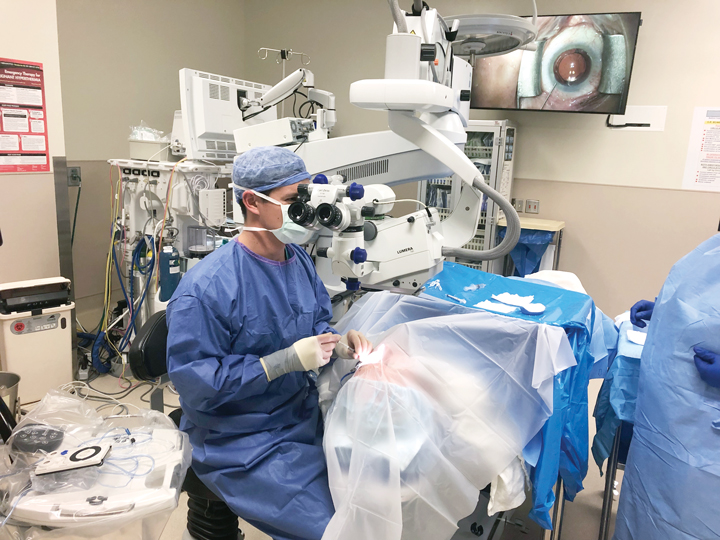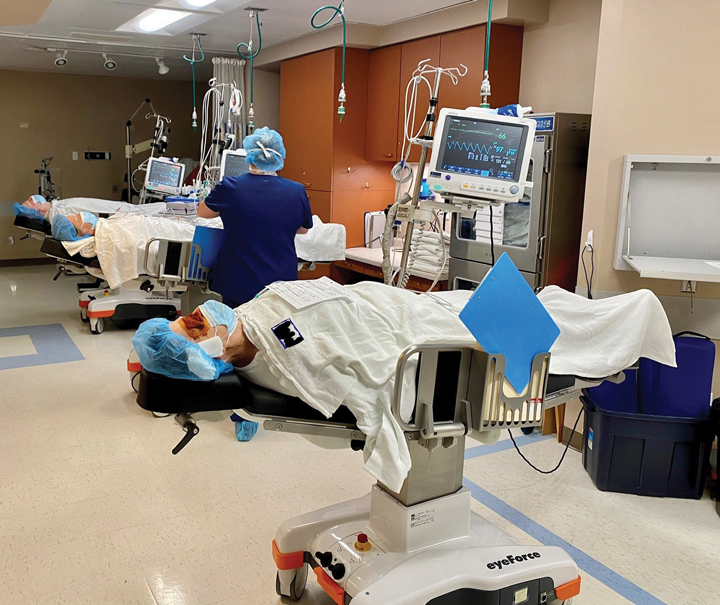- Home
- The Magazine
- Article
Achieving Success With Minimally Invasive Glaucoma Surgery
By: Joe Paone | Senior Editor
Published: 3/7/2023
Numerous MIGS options are providing an attractive middle ground for glaucoma treatment.
The only proven treatment for treating glaucoma is controlling intraocular eye pressure. However, the range of procedures that can achieve this goal vary in terms of invasiveness as well as patient and surgeon comfort.
Beyond traditional treatments
“There’s no one-size-fits-all solution here,” says Robert Stamper, MD, a distinguished professor of ophthalmology at the University of California San Francisco who has been a glaucoma specialist for almost 50 years. Dr. Stamper says an array of new minimally invasive glaucoma surgery (MIGS) devices and techniques over the last decade has better enabled ophthalmologists to treat patients who might not have been well-served by traditional treatments like medications and invasive surgeries like laser trabeculoplasties and iridotomies.
“We didn’t have anything in the middle of our treatment armamentarium until the advent of MIGS,” says Dr. Stamper. “Medications and laser treatments for those with early glaucoma were still effective and useful for most people, and we had surgical procedures for people with severe glaucoma whose conditions were not controlled by those other two modalities. However, those surgeries were accompanied too often for anybody’s comfort by complications that ranged from the annoying, like prolonging the recovery time, to vision-threatening.”
Dr. Stamper says many patients have trouble adhering to medications, which limits the effectiveness of that nonsurgical technique. “Older people often have arthritis or nerve issues that make it difficult to use eyedrops, and some studies show as many as 50% don’t renew their medications because of cost, or because early glaucoma is not symptomatic and sometimes eyedrops can cause discomfort for a condition the patient doesn’t feel until very late in the disease,” he says. The medications also can cause irritation that redden patients’ eyes — “the Bela Lugosi look,” jokes Dr. Stamper — and some patients are allergic to the preservatives in them.
He notes that a biodegradable, sustained release capsule was recently approved that, when injected into the anterior chamber, controls intraocular pressure for six or more months. While it is currently only approved for one-time use, Dr. Stamper expects the technology to be refined to allow effective medical treatment for glaucoma that does not depend on daily drop instillations by patients.
Middle ground

An intermediate treatment step between medication management and more invasive surgery, MIGS enables intraocular pressure control via microstents that increase outflow of aqueous humor through the trabecular meshwork and Schlemm’s canal or while shunting fluid into the supraciliary space. MIGS procedures are frequently performed concurrently with cataract surgeries; Dr. Stamper says they add about five minutes to the episode of care but can offer months if not years of improved intraocular pressure control.
He says MIGS procedures are generally performed with the patient anesthetized through topical eyedrops or through an injection around the eye. The surgeon implants tiny stents that bypass blocked tissue to lower pressure. In other approaches, the outflow of fluid from the eye can be improved by dilating Schlemm’s canal or by tearing open the trabecular meshwork, says Dr. Stamper. For three to four weeks postoperatively, the patient uses eyedrops to prevent infection and ease healing.
The big question for ophthalmologists is which stent or alternative they will use to perform MIGS procedures. “There are a variety of different ways of doing it, and if you’re looking for which one is best, it’s not going to happen for a while,” says Dr. Stamper. “No company is willing to pit their device or methodology against anybody else’s because there’s too much to lose. Maybe one day the National Eye Institute or somebody else will fund a real scientific comparison between the different approaches.”
We’re probably making more money doing the MIGS portion than we do with the cataract surgery portion.
T. Hunter Newsom, MD
In over a decade of experience with MIGS, Dr. Stamper has tried numerous approaches. “I have been very excited about the MIGS programs from the very beginning,” he says. “Some started out looking great but had to come off the market because of one problem or another, as is true with any new approach in medicine. Things pop up that we hadn’t foreseen until they’re tested widely.”
Now that there are several safe, established MIGS stents and procedures available to surgeons, Dr. Stamper advises that, like glaucoma treatments themselves, one size does not necessarily fit all.
For example, he says one popular device is relatively easy for surgeons to place with virtually zero subsequent complications, but doesn’t provide as significant of a drop in intraocular pressure as other options. “It’s a modest addition to the drop you get from cataract surgery,” he says. “But it may allow somebody who had been on two or three medications to go for a few years with just one medication or none.”
One MIGS device he has encountered is larger and more difficult to place. Another is so powerful in adjusting pressure that he tends to use it on patients with advanced glaucoma who need a larger drop in pressure, but not so much that they require traditional glaucoma surgeries.
“We now have an array of tools that may be of slightly increasing effectiveness across the spectrum, so we can try to individualize treatment for exactly what one patient and their particular stage of glaucoma severity needs — how much pressure control they need, for example,” says Dr. Stamper. “In fact, we have probably more MIGS devices now — and a few in the pathway — than what the market can eventually sustain either from a business or medical point of view. No single surgeon is going to be proficient with 15 different MIGS procedures. Ultimately, the market will settle on maybe five or six that will provide that spectrum of choices for both the doctor and the individual patient.”
Dr. Stamper notes that MIGS procedures ultimately only mitigate the patient’s condition temporarily. “Glaucoma is a disease that progresses with age, so most of our surgeries are time-limited,” he says. “They work for three years, five years, sometimes 20 years, but you can’t really predict ahead of time. We can’t just pronounce a patient cured and send them on their way because, as the disease progresses, what we’ve done before might not be adequate as the patient ages and the disease gets worse. There is no cure for glaucoma, just like there’s no cure for diabetes or high blood pressure. We can control it, we can manage it, but it takes two to tango — the doctor and the patient working together.”
MIGS money

The day before we contacted board-certified ophthalmologist T. Hunter Newsom, founder and medical director of Newsom Eye in Tampa, Fla., he had teamed up with another physician to perform 10 concurrent cataract/MIGS procedures. “And we’re going to do maybe eight or nine tomorrow,” he added. “Every cataract surgeon needs to be doing MIGS because, in essence, cataract surgery is now a glaucoma procedure,” says Dr. Newsom. “It’s the number one way to surgically treat glaucoma now.”
His patients’ experience isn’t much different from a standalone cataract surgery. “Postoperatively, it’s pretty similar to regular cataract surgery,” he says. “I tell patients they probably won’t notice much of a difference if we did MIGS or didn’t.”
From a clinical perspective, Dr. Newsom is largely agnostic about using any of the numerous MIGS devices now available. It’s his financial perspective that often drives his decision on which to use. “They all work about the same, and we use all of them,” he says. “It depends on what each patient’s insurance is going to cover.”
Dr. Newsom sees a gold rush of sorts happening with MIGS. “It’s a code with a lot of money attached to it, so everybody’s looking to get a piece of it and coming out with some sort of MIGS device,” he says.
The windfall is also finding surgeons. “We’re probably making more money doing the MIGS portion than we do the cataract surgery portion,” says Dr. Newsom. “I’m not up on all the specifics on the billing, but I might get paid $800 to do a MIGS procedure and $400 to do the cataract surgery. Financially, it’s like, ‘Oh, wait a minute, I’m doing a MIGS surgery, and then my number two procedure happens to be the cataract surgery.’”
Before any of Dr. Newsom’s MIGS patients enter the OR, his back-office team needs to determine which MIGS device a patient’s insurance will cover. “Our insurance verification people see what’s going to be approved and what’s not,” he says. “I often tell patients, ‘We’ll see what your insurance covers and that’s what we’ll do.’ There are all kinds of different stories about what makes one MIGS work better than the other MIGS, but the bottom line is, a lot of the time, it’s not about what you want to do, it’s about what insurance pays. You need to find out what your first option, your second option and your third option is.”
He stresses the importance of making sure whichever MIGS products your surgeons use will be covered to prevent spending $1,000 or $2,000 for a device that isn’t reimbursed by insurance. Dr. Newsom notes that the costs of MIGS devices are now usually bundled with the cataract fees, rather than as a passthrough. Dr. Newsom says his MIGS line is profitable and, just as importantly, the procedures and the devices that go with them have served his patients well.
As a progressive and incurable disease, glaucoma differs in stage, severity and outlook with each patient. With MIGS as an effective option that provides a middle ground between onerous drop regimens and more invasive surgeries, surgeons and their patients can keep glaucoma under control while freeing the patient of excessive drop compliance requirements and more serious post-op recoveries.
“Vision loss from glaucoma is irreversible, and our job as doctors and caretakers is to try to prevent irreversible vision loss that is so severe that it interferes with a person’s ability to drive, read or enjoy life,” says Dr. Stamper. “We really needed something to help patients who had trouble with medications, or who had tried laser treatments that didn’t work or wore off. With MIGS, you don’t disrupt tissue very much and therefore, the risks of serious complications drop off precipitously.” OSM
.svg?sfvrsn=be606e78_3)
.svg?sfvrsn=56b2f850_5)